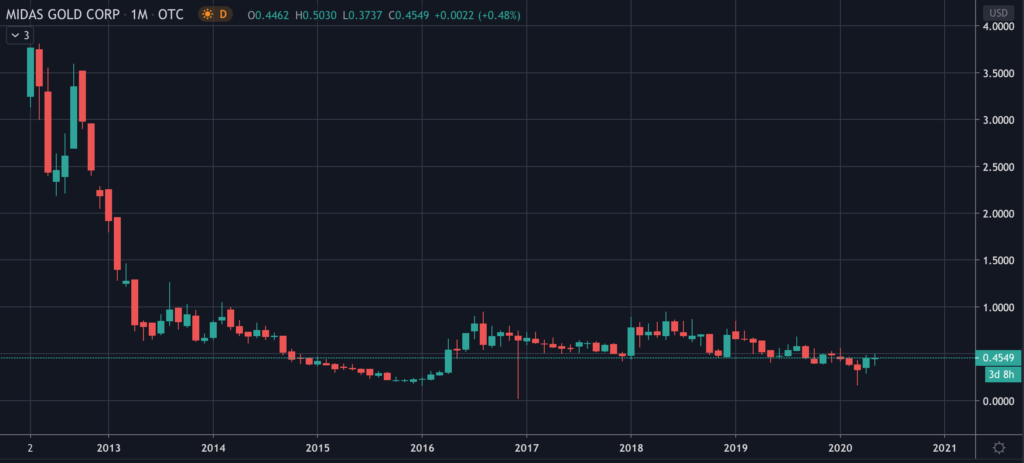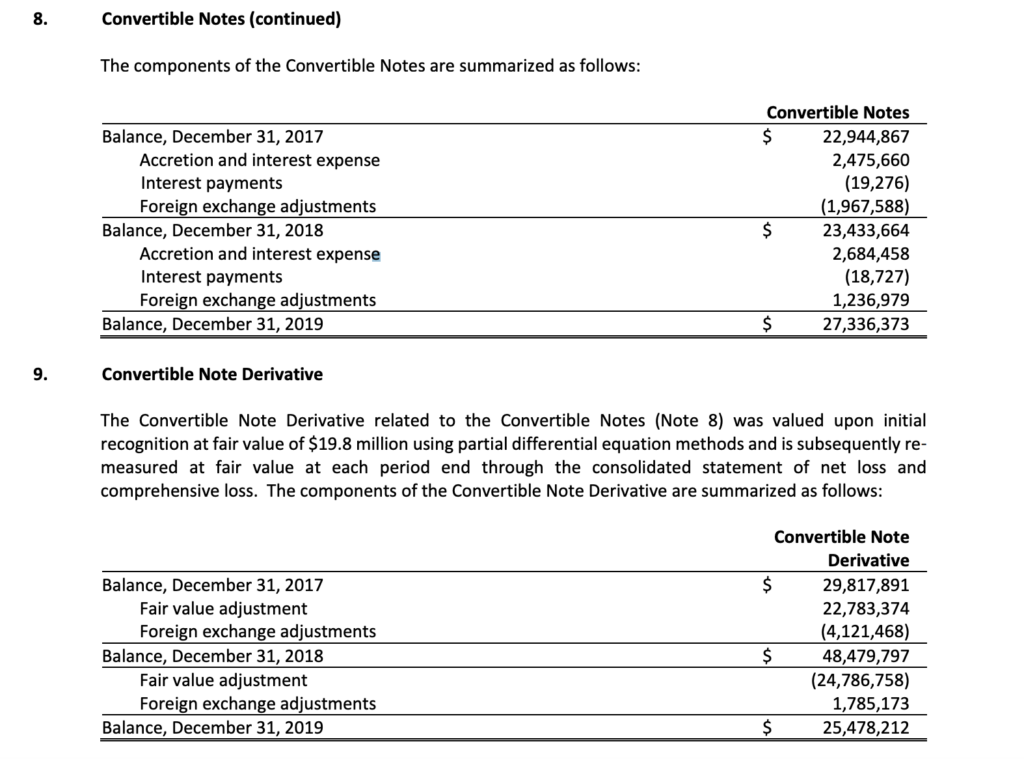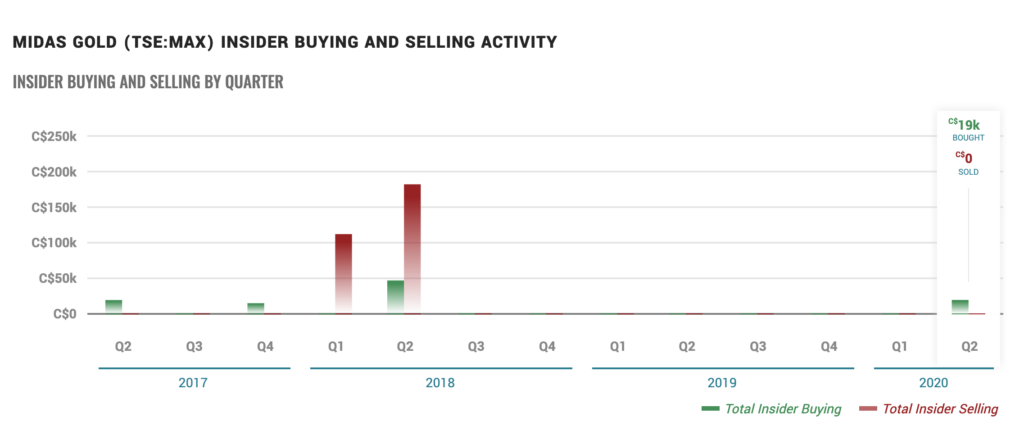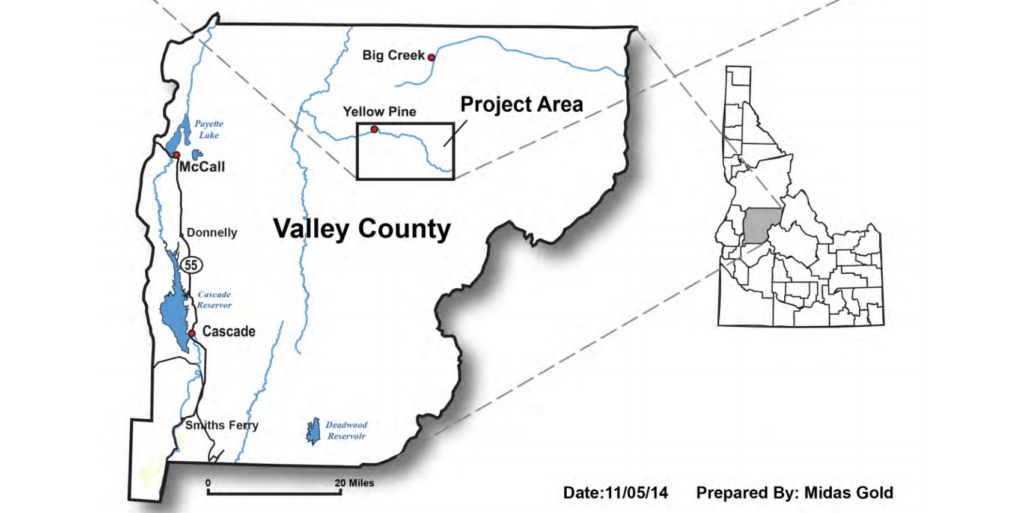Common Stock: Midas Gold Corporation (TSX: MAX, OTC: MDRPF)
Current Market Price: $0.45
Market Capitalization: $123.5 million

Midas Gold Stock – Summary of the Company
Midas Gold Corporation is a mining company focused on the acquisition, exploration, and development of gold mining properties in North America. Their principal project is the Stibnite Gold Project in Idaho. They also have several other exploration stage projects. Midas Gold was founded in 2011 and is headquartered in Vancouver Canada. They have 39 employees, most of whom work in Idaho.
Revenue and Cost Analysis
Midas Gold only has exploration stage projects; therefore, they do not have any revenues. The company consistently has a net loss and will likely continue to lose money for the foreseeable future.
In 2019, the company had an operating loss of $31 million, slightly more than 2018’s operating loss of $28 million. The majority of this $31 million loss was spent on exploration expenses, which totaled $26.8 million.
The company estimates the capital cost to bring the Stibnite project into production would be around $1.1 billion, including $970 million in startup costs.
Midas Gold – Royalty and Streaming Agreements
The Stibnite Gold Project is subject to a 1.7% net smelter royalty.
Balance Sheet Analysis
Midas Gold has an OK balance sheet. They have sufficient short term liquidity and a strong long term asset. However, they have high long term liabilities and debt levels.
At the end of 2019 the company had $18.4 million in current assets, including $17.5 million in cash. The had only $4.6 million in current liabilities.
Most of the company’s assets are long term assets, mainly a long term exploration and evaluation asset valued at $71.4 million. Total assets were $90.5 million at the end of 2019, compared to $57.7 million in total liabilities. Most of these liabilities are debt related (discussed below).
Midas Gold – Debt Analysis
Midas has high balance sheet debt levels totaling $52 million at the end of 2019. However, this is convertible debt which will not result in a cash outflow upon conversion. Annual interest expense is very low, .05%.
Although the debt maintenance is low, it is highly dilutive. Should the debt be converted in full it would nearly double the company’s shares outstanding.

Midas Gold Stock – Share Dynamics and Capital Structure
As of March 2020 Midas Gold had 271 million common shares outstanding. The company has significant dilutive instruments outstanding, including 2 million warrants (owned by Franco Nevada) and 19.7 million options. Fully diluted shares outstanding (not including the convertible debt) is around 296 million shares.
If the convertible debt is converted in full it would result in an additional 243 million shares being issued.
Midas Gold has a highly dilutive capital structure. Investors should carefully consider their place in the capital structure before investing.
Midas Gold – Significant Owners
Barrick Gold owns a significant interest in the company, around 20%.
Midas Gold Stock – Dividends
The company does not currently pay a dividend and is unlikely to do so in the short to medium term.
Management – Skin in the game
There has not been any relevant insider trading in Midas Gold stock.

Midas Gold Stock – 3 Metrics to Consider
Debt to Equity Ratio
Total Liabilities/Total Share Holder Equity
$57.7 million/$32.7 million = 1.7
A debt to equity ratio of 1.7 implies that the company’s capital structure is comprised of mostly debt. Midas may be reliant on debt financing to fund itself in the future.
Price to Book Ratio
Current Share Price/Book Value per Share.
$.45/$.06 = 7.4
Based on my estimate of fully diluted shares outstanding, including the convertible debt, Midas Gold has a book value per share of $.06. At the current market price this implies a price to book ratio of 7.4 A price to book ratio of 7.4 means Midas gold trades at a significant premium to the book value of its assets.
Working Capital Ratio
Current Assets/Current Liabilities
$18.4 million/$4.6 million = 4
A working capital ratio of 4 indicates strong balance sheet liquidity. It is likely Midas will be able to meet its balance sheet obligations in the short term. However, given the company’s high burn rate related to its operations, Midas may need to raise additional capital in the short to medium term.

Gold Market – Economic Factors and Competitive Landscape
Gold mining is a highly competitive, capital intensive business. The company will need to compete fiercely for both new projects and capital. However, given the current economic environment of global money printing and zero or negative interest rates, it would appear gold companies are poised to benefit from a strong economic tailwind.
Midas Gold Stock – Summary and Conclusions
Midas Gold owns a very promising project in a very strong jurisdiction. They have strong investors such as Franco Nevada and Barrick gold.
However, Midas has a highly dilutive capital structure. In addition to options and warrants outstanding, the company has convertible debt that would nearly double its shares outstanding if converted. Based on this potential dilution Midas Gold stock trades at a very high premium relative to the value of its assets.
At the current market price, Midas Gold does not have a sufficient margin of safety to compensate investors for the risks associated with a single asset, exploration stage mining company. For those reasons, I will not be investing in Midas Gold common stock.
Disclaimer
This is not investment advice. Nothing in this analysis should be construed as a recommendation to buy, sell, or otherwise take action related to the security discussed. If I own a position in the security discussed, I will clearly state it.
This is not intended to be a comprehensive analysis and you should not make an investment decision based solely on the information in this analysis. I hope this serves as a useful starting point for a more comprehensive analysis, and hopefully draws attention to aspects of the company that were overlooked or merit further investigation. This is by no means intended to be a complete analysis. Again, this is not investment advice, do your own research.
One Comment
Comments are closed.